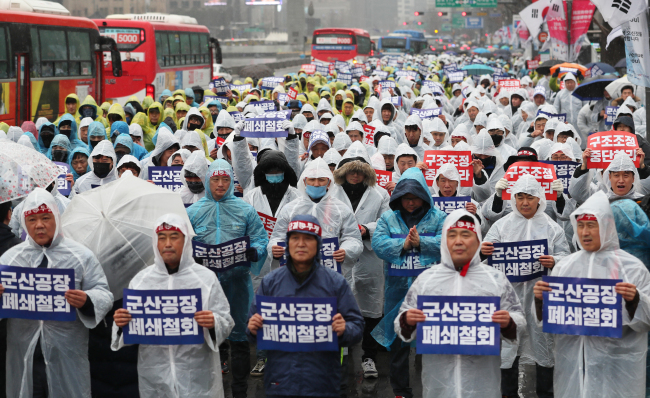Voluntary resignations fail to resolve GM Korea’s deficit
By Kim Bo-gyungPublished : March 4, 2018 - 15:29
As GM Korea continues looking for ways to tighten its belt to restructure the struggling company, some 2,500 employees have signed up for voluntary redundancy.
But the automaker has to take more measures, such as reducing labor expenses and lowering the cost-to-sales ratio, to complete a turnaround, industry experts said Sunday.
From the voluntary redundancies applications made as of Friday, GM Korea is expected to save up to 400 billion won ($370 million) in labor and overhead costs.
Given that the company’s losses averaged an annual 750 billion won over the past four years, GM Korea has to look for ways to cut another 350 billion won.
Some 1,000 workers out of 1,550 at the Gunsan plant in North Jeolla Province applied for voluntary redundancy as of last Friday, the company said.
The number rises to some 2,500 workers when including applications from workers at GM’s Bupyeong and Changwon factories. This leaves 13,600 remaining workers at GM Korea.
“With some 2,500 workers who have applied for voluntary redundancy, GM Korea now either has to let go of some 1,000 workers or reduce labor costs of the remaining workers,” said Oh Il-sun, head of the Korea CXO Institute.
“As for the management, GM needs to lower the cost-to-sales ratio and R&D expenses in order to turn around the balance sheet.”
But the automaker has to take more measures, such as reducing labor expenses and lowering the cost-to-sales ratio, to complete a turnaround, industry experts said Sunday.
From the voluntary redundancies applications made as of Friday, GM Korea is expected to save up to 400 billion won ($370 million) in labor and overhead costs.
Given that the company’s losses averaged an annual 750 billion won over the past four years, GM Korea has to look for ways to cut another 350 billion won.
Some 1,000 workers out of 1,550 at the Gunsan plant in North Jeolla Province applied for voluntary redundancy as of last Friday, the company said.
The number rises to some 2,500 workers when including applications from workers at GM’s Bupyeong and Changwon factories. This leaves 13,600 remaining workers at GM Korea.
“With some 2,500 workers who have applied for voluntary redundancy, GM Korea now either has to let go of some 1,000 workers or reduce labor costs of the remaining workers,” said Oh Il-sun, head of the Korea CXO Institute.
“As for the management, GM needs to lower the cost-to-sales ratio and R&D expenses in order to turn around the balance sheet.”

GM Korea and the labor union will hold wage negotiations in the coming week, where GM Korea is widely expected to continue its push for a wage freeze and suspension of bonuses for 2018 in a move to restore production competitiveness.
If the wage negotiations go through, GM Korea will be able save about 140 billion won in bonuses and 150 billion won in welfare payments, nearing the additional reduction the company has to make, the company said.
According to a report released by Oh on GM Korea, GM could do its part by lowering the cost-to-sales ratio to 88 percent and money spent on sales management to 9 percent, ultimately to post an operating profit of 330 billion won.
The calculation was made under the assumption that GM Korea’s annual sales total some 11 trillion won, a moderate figure compared to 12.3 trillion won in 2016.
The cost to sales ratio of vehicles assembled at the Gunsan plant averaged over 90 percent over the last four years, which is about 10 percent higher than the market average.
An annual 200 billion won could be saved by downsizing research and development by 1.5 percentage points, the report added.
GM Korea spent 614.1 billion won on research and development in 2016, more than its 521.9 billion won operating loss, according to the Financial Supervisory Service.
As the second-largest stakeholder of GM Korea with a 17.02 percent share, the state-run Korea Development Bank said it would examine financial records on the controversial cost-sales ratio and R&D costs.
GM Korea said it was unlikely to extend the deadline for voluntary redundancy applications, and denied reports that the company had submitted plans to shed 5,000 workers to the government.
By Kim Bo-gyung (lisakim425@heraldcorp.com)









![[Kim Seong-kon] Democracy and the future of South Korea](http://res.heraldm.com/phpwas/restmb_idxmake.php?idx=644&simg=/content/image/2024/04/16/20240416050802_0.jpg&u=)







![[KH Explains] Hyundai's full hybrid edge to pay off amid slow transition to pure EVs](http://res.heraldm.com/phpwas/restmb_idxmake.php?idx=652&simg=/content/image/2024/04/18/20240418050645_0.jpg&u=20240418181020)

![[Today’s K-pop] Zico drops snippet of collaboration with Jennie](http://res.heraldm.com/phpwas/restmb_idxmake.php?idx=642&simg=/content/image/2024/04/18/20240418050702_0.jpg&u=)